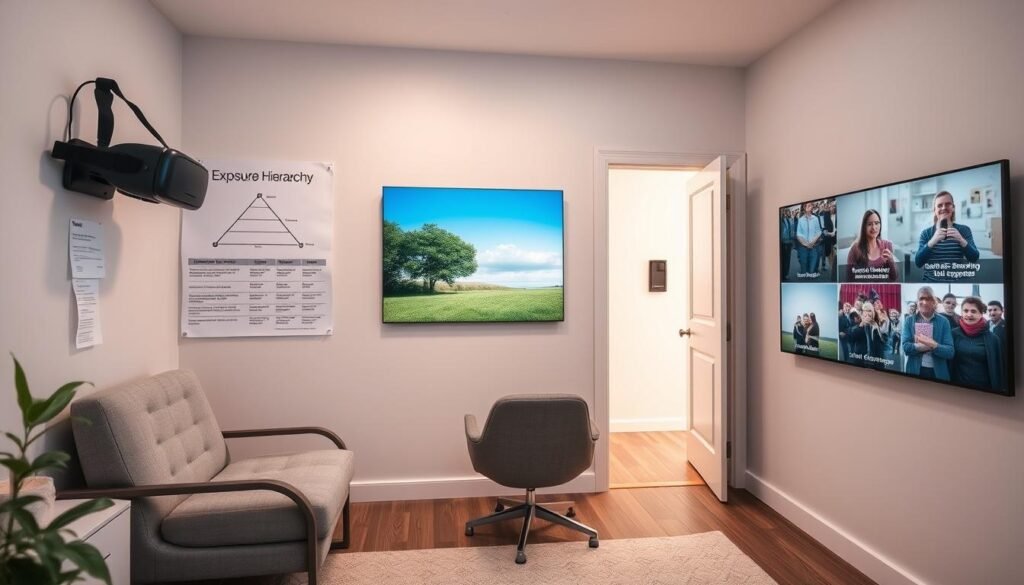About 1 in 5 adults in the United States face an anxiety disorder. This fact shows how common fear and anxiety are, affecting daily routines. Luckily, exposure therapy is a top method to fight fears linked to anxiety disorders. By facing fears little by little, people can see their anxiety drop. This change can make life more enjoyable.
This guide will cover the different exposure therapy methods, why they matter, and their workings. By knowing and using these steps, people can actively lessen their fears. This effort can boost the joy and value in their lives.
Key Takeaways
- Exposure therapy is highly effective for anxiety disorders.
- Gradual exposure is crucial for successful treatment outcomes.
- Long-term benefits include reduced fear and improved self-efficacy.
- Regular practice helps maintain gains achieved during therapy.
- A fear hierarchy aids in structuring exposure steps.
- Tracking fear levels can enhance understanding of progress.
- Rewarding progress is beneficial for motivation.
Understanding Exposure Therapy
Exposure therapy is a key psychological treatment. It helps people face their fears in a safe environment. By exposing patients to what they fear, the therapy makes them see the dangers aren’t as big as they think. This way, it can improve their lives by reducing avoidance behaviors.
What is Exposure Therapy?
It’s a proven treatment for mental health issues, especially anxiety, phobias, and PTSD. The therapy includes around 8 to 15 sessions, each lasting about 90 minutes. Patients slowly confront their fears, learning to handle their reactions. Understanding this process is key for both people and therapists for success.
Types of Exposure Therapy
There are different types of exposure therapy for psychological help. Some key methods include:
| Type of Exposure Therapy | Description |
|---|---|
| In Vivo Exposure | Engaging with real-life situations that provoke fear. |
| Imaginal Exposure | Vividly imagining feared scenarios to process emotions. |
| Virtual Reality Exposure | Utilizing technology to simulate experiences that are hard to replicate. |
| Interoceptive Exposure | Confronting feared bodily sensations associated with anxiety, enhancing coping mechanisms. |
Each type of exposure therapy offers different ways to face fears, based on what each person needs. A trained therapist guides this, creating a safe space for growth. For more details on exposure therapy, check this resource.
The Importance of Facing Your Fears
Facing fears is key to managing anxiety. Avoiding what scares us may feel good at first but makes anxiety worse later on. Tackling fears directly can change how we feel and help us cope better.
The Impact of Avoidance on Anxiety
Avoiding scary situations can make anxiety and fear grow. When we avoid things that make us anxious, our brains learn to fear those situations even more. This can make us more anxious in the future.
For example, if we react by wanting to run away or fight in safe places like public transport, we start to see danger where there is none. This makes our fear and anxiety even worse.
Benefits of Confronting Fears
Facing our fears has many advantages. When we slowly start to face what scares us, our anxiety decreases and we become more confident. This process involves steps like rating how much something scares us. It helps decide what to face first to get better.
By facing our fears more and more, they start to scare us less. We also learn how to deal with our fears better. This makes us stronger and better at handling anxiety.
| Benefits of Exposure | Description |
|---|---|
| Increased Confidence | Facing fears helps develop a sense of accomplishment and self-efficacy. |
| Reduced Anxiety Levels | Gradual exposure directly contributes to a significant reduction in anxiety symptoms. |
| Improved Quality of Life | Successfully confronting fears allows individuals to engage in activities previously avoided. |
| Development of Coping Skills | Individuals learn practical techniques for managing anxiety more effectively. |
Exposure therapy has many benefits for those trying to overcome their fears. It’s a top method for dealing with specific phobias and making life better.
How Exposure Therapy Works
Understanding how exposure therapy helps people with anxiety and fears is important. This method uses systematic steps to expose individuals to what scares them. It helps them become less sensitive over time. The key parts of this process are habituation and extinction. Both are crucial for the success of exposure therapy.
Gradual Exposure Techniques
Gradual exposure is vital for exposure therapy’s success. It exposes people to their fears slowly and safely. They start with easier stuff and move to harder challenges. This is done through something called graded exposure.
A “fear ladder” lists fears from least to most scary. It helps patients face their fears at their own pace.
- In Vivo Exposure: Direct confrontations with feared objects or situations in real life.
- Imaginal Exposure: Vividly imagining the feared scenario to process emotions safely.
- Virtual Reality Exposure: Utilizing VR technology to simulate fear-inducing environments.
- Interoceptive Exposure: Focusing on internal bodily sensations associated with anxiety.
The Role of Habituation and Extinction
Habituation helps the body react less to fear after repeated exposure. As people face their fears more, they often feel less anxious. This adaptation reduces sensitivity over time.
Extinction helps by breaking the link between fear and bad outcomes. Facing fears without bad things happening weakens old fear responses. Habituation and extinction together make exposure therapy work well against anxiety issues, like phobias, PTSD, and OCD.

Creating a Fear Hierarchy
A fear hierarchy is key in exposure therapy. It slowly lets people face their fears by ranking them. Fears are listed from the least to most scary. This way, people can tackle their fears step by step. Learning to make a fear hierarchy is a must for exposure therapy.
What is a Fear Hierarchy?
A fear hierarchy ranks fears so people can face them bit by bit. It’s used for conditions like OCD and other anxiety issues. Fears are scored from 0 to 10, with 0 being no fear and 10 being the highest fear. This scoring helps people work through their anxiety systematically in exposure therapy.
Steps to Build Your Fear Ladder
To make a useful fear ladder, follow these steps:
- Identify Specific Fears: Write down all fears, whether they’re about germs, danger, or social events.
- Rate Anxiety Levels: Use the SUDS scale to give each fear a distress level.
- Organize from Least to Most Anxiety-Provoking: Put your fears in order by their ratings, making a plan.
- Develop Exposure Strategies: Choose how you’ll face your fears, like through real-life situations, imagination, or digital means.
- Implement Gradual Exposure: Start with the least scary situation and slowly move to the harder ones.
This methodical approach helps improve exposure therapy. It also helps people gradually overcome their anxiety.

Variations of Exposure Therapy
Exposure therapy offers different approaches tailored to each person’s needs and fears. Each method has a unique focus, helping people face their fears effectively.
In Vivo Exposure
In vivo exposure helps people face fears in real-life situations. It encourages people to directly confront their anxieties. This might include meeting a feared animal or engaging in a feared activity.
Its strength lies in making individuals accustomed to their fears through repeated exposure. This reduces their anxiety over time.
Imaginal Exposure
Imaginal exposure uses vivid imagination to confront stressful events. It’s especially helpful for those with PTSD or who have experienced trauma. By imagining fearful scenarios, people can start to process their emotions.
This helps decrease the intensity of their fears, aiding in recovery.
Virtual Reality Exposure
Virtual reality therapy uses immersive technology to simulate experiences. This is helpful when actual exposure is not feasible. It allows individuals to safely face their fears in a controlled environment.
They receive support throughout the process.
Interoceptive Exposure
Interoceptive exposure deals with feared bodily sensations linked to anxiety. It’s vital for individuals with panic disorder. By experiencing and managing these sensations, people learn to cope better.
This approach teaches that such sensations are manageable and not harmful.
| Method | Description | Benefits |
|---|---|---|
| In Vivo Exposure | Facing fears directly in real-life situations. | Reduces avoidance behavior; builds confidence. |
| Imaginal Exposure | Vividly imagining feared events for processing. | Helps with PTSD; aids in emotional processing. |
| Virtual Reality Exposure | Immersive experiences in a controlled setting. | Safe confrontation of fears; practical for difficult scenarios. |
| Interoceptive Exposure | Confronting feared bodily sensations. | Reduces fear of sensations; improves coping strategies. |
These variations of exposure therapy are scientifically supported. They can be customized for different needs. For deeper insights on these methods, visit exposure therapies for specific phobias.

Implementing Exposure Therapy Techniques
To make exposure therapy work, a smart plan is needed. Starting with a plan that pinpoints specific fears is key. It also lists how to tackle them step by step. Using these techniques in order makes it easier for people to deal with anxiety and push past their fears.
Developing a Personalized Exposure Plan
A plan made just for you focuses on what you need and what scares you. It should have:
- Specific Goals: Clear goals help keep focus and show progress.
- Timelines: Deadlines make sure you stay on track.
- Gradual Exposure Steps: Start with less scary things, then take on bigger challenges.
Building confidence takes time and careful planning. With progress tracking and thinking over what you’ve learned, staying motivated gets easier.
Practicing Regularly for Success
Being consistent is crucial. Practicing often makes the learning stick and coping skills stronger. Giving time to this helps lower fear responses bit by bit.
Regular practice brings:
- Increased Self-Efficacy: Small wins build confidence in facing fears.
- Habituation: Repeated exposure lowers sensitivity to what scares you.
- Emotional Processing: Understanding and healing from emotions tied to fears.
Sticking with it means seeing real change and getting better at handling anxiety.
Common Challenges in Exposure Therapy
Exposure therapy is hard, especially for those with anxiety disorders. It requires facing fears directly, which can bring up strong emotions and resistance.
Overcoming Initial Resistance
Many people resist at the start of exposure therapy. They worry about being judged or facing their fears. Teaching them about the process helps break down these fears.
Learning the benefits of exposure therapy can inspire them. Supportive strategies are key to overcoming resistance and challenges.
Managing Difficult Emotions During Exposure
Handling emotions is important in exposure therapy. Feelings like embarrassment and fear can make things harder. Grounding methods, positive self-talk, and relaxing can help manage these feelings.
Self-care is also crucial for both dealing with tough emotions and achieving long-term success. Practices like recognizing your progress are important for building resilience.
Seeking Professional Help
Struggling with anxiety or big fears calls for professional help on the road to recovery. Self-help often falls short, making a therapist’s guidance crucial when difficulties pop up. They offer specialized exposure therapy in a safe, planned way.
When to Consult a Therapist
Consider a therapist if doing it alone doesn’t help much or stress gets worse. You should seek help when:
- Persistent anxiety disrupts everyday life.
- You feel hopeless or too stressed.
- Tackling triggers alone doesn’t work.
- New fears arise or symptoms worsen after trying to handle it yourself.
How Professionals Apply Exposure Therapy
Experts have different techniques for effective exposure therapy. These include:
- Gradual Exposure: Introducing fears slowly to foster confidence.
- Prolonged Exposure: Teaching about symptoms, using calming methods, and facing fears directly.
- Systematic Desensitization: Mixing relaxation with facing fears.
- Flooding: Starting with toughest fear for quick adjustment.
Therapists assist clients in processing emotions, navigating through complex feelings, and dealing with challenges. Research shows professional exposure therapy significantly reduces fear and avoidance. Many report major improvements after treatment.
Conclusion
Exposure therapy is a key way to beat fears and handle anxiety. It helps over 40 million adults in the U.S. facing anxiety disorders. By facing their fears little by little, people build up emotional strength. They learn important ways to deal with tough situations in the future.
This therapy not only lowers anxiety but also helps people grow personally and improve their mental health. Studies show that people with traumatic experiences, like PTSD, often choose exposure therapy. This shows it’s a well-liked option. Plus, methods like virtual reality make it even more appealing and useful today.
For those wanting to dig deeper into how this therapy works, it’s a good idea to read up on it. Effective strategies are outlined in detailed studies. They show how exposure therapy can really change lives for the better. It helps change unfounded fears into realistic thoughts and actions.